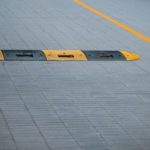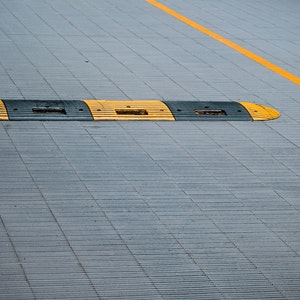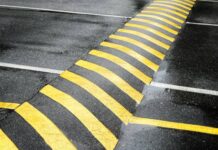Rubber speed bumps are a standard traffic calming device that keeps reckless driving under check and offers enhanced safety for pedestrians. They are considered the most effective method of slowing motorists down, as they are easily noticeable and durable. In addition, they are a cost-effective way to achieve traffic speed reduction.
 However, rubber speed bumps are regarded as tripping hazards for pedestrians and even have a bad reputation for damaging a car’s wheel alignment — though a closer look into the matter indicates the real culprits are drivers who carelessly race over speed bumps and do not slow down their vehicles.
However, rubber speed bumps are regarded as tripping hazards for pedestrians and even have a bad reputation for damaging a car’s wheel alignment — though a closer look into the matter indicates the real culprits are drivers who carelessly race over speed bumps and do not slow down their vehicles.
Transportation engineers often suggest substituting rubber speed bumps with equally effective traffic-calming alternatives. Unfortunately, the proposed alternatives are accompanied by problems that are too noticeable to be overlooked.
Let us look at the common substitutes of rubber speed bumps and why they may not be the best-suited options for roadways.
Traffic signals
 We all know the red, yellow, and green lights installed on the roadways. These traffic lights are the most popular traffic calming tools used by the authorities — they can be found at most of the world’s intersections.
We all know the red, yellow, and green lights installed on the roadways. These traffic lights are the most popular traffic calming tools used by the authorities — they can be found at most of the world’s intersections.
Though they are compelling enough to make the motorists reduce the speed of their vehicles, they have certain disadvantages. The most common problem is that these lights increase traffic congestion, especially during peak activity hours. They are even the cause of many rear-end collisions — so they may cause more accidents than preventing them. Therefore, they alone are not an excellent substitute for rubber speed bumps.
Speed cameras
Many governments have even leveraged the power of cameras to catch the culprits and impose a fine. The idea behind installing speed cameras on roads is to target drivers who disobey speed limit signs, specifically on highways. Once identified, the accused motorist is fined a heavy sum, therefore, is less likely to violate traffic laws in the future.
The most common disadvantage of a speed camera is it does not promise accurate results. Such cameras work like radar and can often produce incorrect results. As a result, a wrong ticket is generated for false readings, and an innocent individual is wrongly fined.
Curb extensions
Curb extension is also a common traffic calming measure that physically and visually narrows the roadways and offers more walking space for pedestrians. It even increases the space for installing street furniture, like benches and planting trees. Residential streets and downtown areas are common spaces that can benefit from curb extensions.
Unfortunately, they have certain disadvantages as well. Firstly, they do not work for narrow roadways and deprive vehicles of on-street parking. In addition, they even preclude a car’s ability to make right turns when the traffic light is red.
Speed tables
Like rubber speed bumps, speed tables are vertical deflections that compel drivers to reduce their vehicle’s speed and watch out for the pedestrians crossing the roads. They are a raised section of the road with ramps on both ends. The ramps on these speed tables are often painted with white arrows for enhanced visibility.
The common problem with a speed table is that it is expensive to install one. Besides, they are not ideal for vehicles with low ground clearance and occupy more space. Lastly, water drainage could be a problem on surfaces with speed tables.
Bottom line
 It is important to note that all speed limiting measures — even rubber speed bumps — have their pros and cons. None of these measures alone are capable of fully preventing accidents. That said, these traffic calming strategies complement each other and produce an anticipated result when paired wisely.
It is important to note that all speed limiting measures — even rubber speed bumps — have their pros and cons. None of these measures alone are capable of fully preventing accidents. That said, these traffic calming strategies complement each other and produce an anticipated result when paired wisely.
For instance, speed limiting signs are an incredible accompaniment to rubber speed bumps. For enhanced safety, identify which traffic calming measures will be the most advantageous in a specific area and leverage these tools wisely to achieve the desired result.
Address
Commonwealth Paving, 136 Outerloop, Louisville, Kentucky 40214
Phone: 502-459-7283, Fax: 502-456-2678
Opening Hours
| Monday | 9:00 AM – 5:00 PM |
| Tuesday | 9:00 AM – 5:00 PM |
| Wednesday | 9:00 AM – 5:00 PM |
| Thursday | 9:00 AM – 5:00 PM |
| Friday | 9:00 AM – 5:00 PM |
| Saturday | Closed |
| Sunday | Closed |







